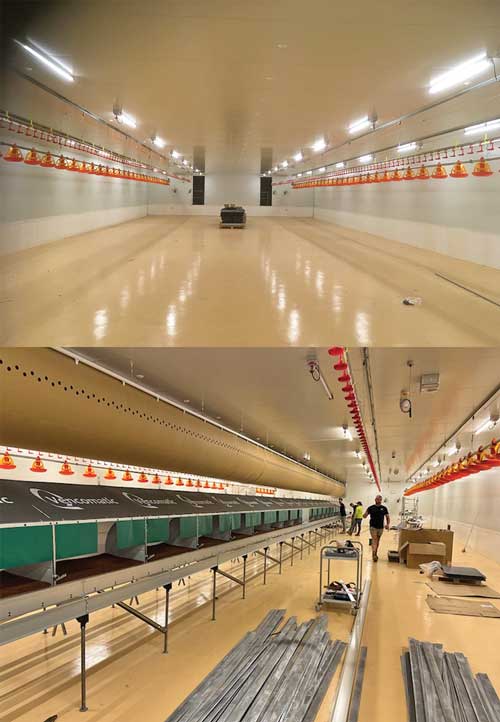ABOVE: AusSPF has invested heavily in expanding production capability to meet the increasing demand for its eggs.
Australian SPF Services Pty Ltd director of operations Greg Lea updated Australasian Veterinary Poultry Association president Angela Scott with its activities recently.
Following is Greg’s update as at early March 2024, which has been edited to suit publication.
AusSPF Services Pty Ltd has, over the past five years, invested heavily in expanding production capability to meet the increasing demand for Australian specific pathogen-free eggs and improve the continuity of supply.
Our investment in a second site at Lancefield mitigates the risk to supply if there is a disease incursion and facilitates the importation of new genetic SPF parent breeder fertile eggs when required.
As you know, until the commissioning of our new post-entry quarantine facility, there was no pathway, government sponsored or private, for the importation of SPF parent breeders.
The absence of any SPF import facility specifications proved a complication and caused delay.
We worked closely with the Department of Agriculture, Fisheries and Forestry to develop appropriate specifications and are grateful for its support in completing this important project.
Facility update
At Woodend, AusSPF has for many years leased a parcel of land from Seqirus on which is located a small hatchery, grow-out shed and two production sheds.
There are no plans to expand this facility.
At Lancefield, our new 40.5ha property is situated about 30 minutes’ drive from Woodend in a suitably isolated location.
We have an approved development application for one hatch/grow shed and three production sheds on the site.
We have built and stocked the first production shed.
SPF eggs from this site are currently available to our customers.
Currently, we are producing a substantial surplus and needing to discard first-grade eggs.
The Lancefield site is now certified for export following an onsite audit by DAFF.
Standards applied were WOAH 2023, sections 6.5 and 6.6, and the European Union requirements.
Facilities at the new site include expanded high-voltage electrical supply, feed and consumables storage, egg dispatch cool room, office facilities and two backup generators.
The PEQ building is nearing completion, with the heating, ventilation, air-conditioning and other equipment all on site awaiting installation.
We plan to have this facility tested and approved by DAFF in time for our first importation of Valo breeding stock since 2010, to take place in July-August 2024.

Investment in a second site mitigates the risk to supply if there is a disease incursion and facilitates the importation of new genetic SPF parent breeder fertile eggs when required.
Flock programming
Prior to the new flock placement at Lancefield, we had two flocks at Woodend, overlapping in lay for two three-month periods each year.
The Lancefield ‘production shed 1’ ensures we will have two flocks continuously in lay.
The extra production capacity will ensure a moderate surplus over and above the Australian requirement at least for the next two to three years.
One grow-out shed can supply three production sheds annually.
The second and third production sheds at Lancefield can therefore be programmed for completion quite easily.
Supply risk assessments and mitigations
SPF operations are of a unique nature, with risk levels higher than most other poultry business operations.
Our risk assessments give special attention to outcomes of the root cause analysis undertaken following disease incursions.
We are encouraging a risk-averse management culture to prevent incursions and disruption in supply.
These are paramount management strategies.
Risk-averse management strategies have been implemented in planning for Lancefield, with greater shed isolation than was physically possible at Woodend.
For example, each shed has its own biosecurity fence and double shower-in procedure.
They are about 300m apart, with separate entrances and no overlapping staff.
We anticipate that the PEQ will be used once every three or four years to receive up-to-date parent stock.
This hatch-grow facility is in addition to the facility at Woodend, providing redundancy in hatchery and grow-out capacity.
This will provide risk management options that we have never had before if a disease outbreak situation occurs on either site.
Thus, our improved risk management strategy now includes two sites, more and better isolated production sheds, duplication of hatch-grow capacity on separate sites and the ability to quickly import new parent stock.
At the AVPA conference last November, there was some criticism that we did not maintain a continuous isolated third production flock.
Such criticism is undeserved.
In fact, we now operate three isolated production sheds, with the other risk management measures mentioned.
We plan to over-produce to meet unexpected demand.
It is, however, impractical for a private business to do more.
We would welcome new entrants to the SPF egg production business.
However, the cost and risks associated with the production of SPF eggs is a serious disincentive.
One solution may be to lobby DAFF or the poultry industry to establish a flock to provide cover in the event of a disease incursion.
We would willingly cooperate with any such proposal.
Greg Lea
AusSPF Director of Operations

